If you want to know about the general building requirements or circulation in architecture or residential space planning, please click the link.
- Cluster planning is recognized to be consistent with traditional Indian lifestyle. This has also been an accepted traditional practice all over the world.
- The cluster concept has been accepted now as economic necessity and desirable socially to promote desired lifestyle. Cluster planning has proved to be a powerful urban design tool, yet number of conventional byelaw provisions, such as set-back and coverage hinder efficient planning based on cluster concept.
- This standard is intended to serve as a guide for local bodies/authorities to adopt cluster planning for providing low income housing and resettling slum dwellers.
- Cluster planning is one of the better options available which provide appropriate physical spaces that are conducive to community life and development. Wherever such planning is adopted, this should be regulated by the provisions recommended in this standard.

- These guidelines cover planning and building requirements of housing developed as clusters. These requirements are applicable to all housing projects taken up by public, private or cooperative agencies.
1) Terminology
i) Cluster
- Plots or dwelling units or housing grouped around an open space (see Figure above). Ideally housing cluster should not be very large.
- In ground and one storeyed structures not more than 20 houses should be grouped in a cluster. Clusters with more dwelling units will create problems in identity, encroachments and of maintenance.
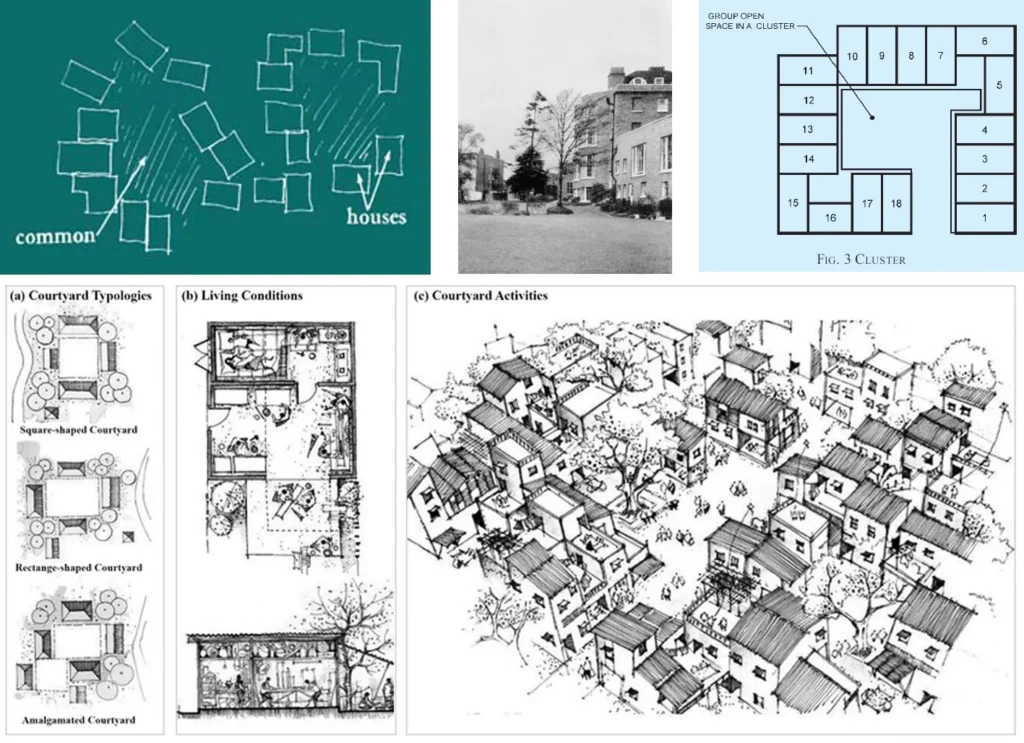
- A residential cluster development, or open space development, is the grouping of residential properties on a development site to use the extra land as open space, recreation or agriculture.
- People will not feel comfortable in their houses unless a group of houses forms a cluster, with the public land between them jointly owned by all the householders.
- Therefore, Arrange houses to form very rough, but identifiable clusters of 8 to 12 households around some common land and paths. Arrange the clusters so that anyone can walk through them, without feeling like a trespasser.
ii) Back-to-Back Cluster
Clusters when joined back to back and/or on sides
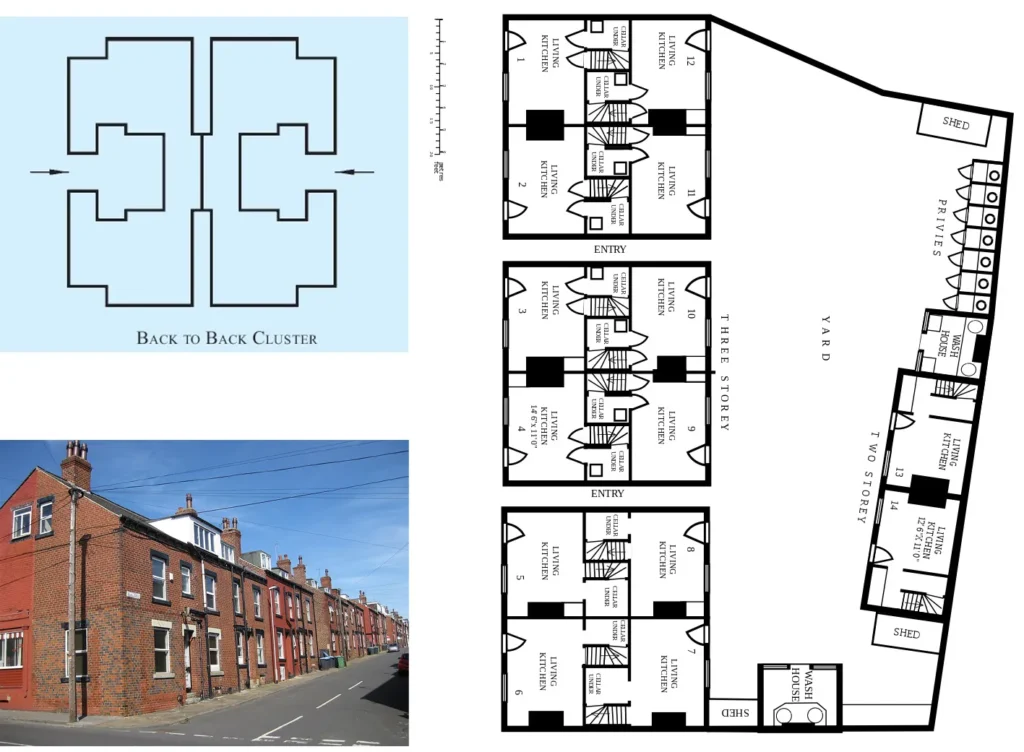
iii) Closed Clusters
Clusters with only one common entry into cluster open space.
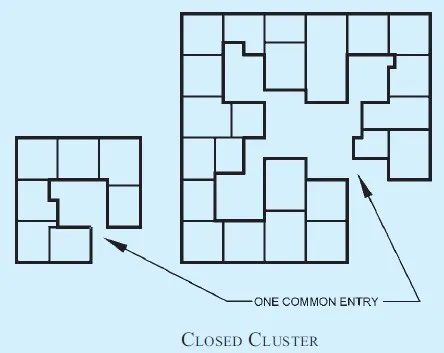
iv) ‘Cul-de-Sac’ Cluster
Plots/dwelling units when located along a pedestrianized or vehicular ‘cul-de-sac’ road.

- A dead end, also known as a cul-de-sac no through road or no exit road, is a street with only one inlet or outlet
v) Independent Cluster
Clusters surrounded from all sides by vehicular access roads and/or pedestrian paths.

vi) Interlocking Cluster
- Clusters when joined at back and on sides with at least one side of a cluster common and having some dwelling units opening onto or having access from the adjacent clusters.
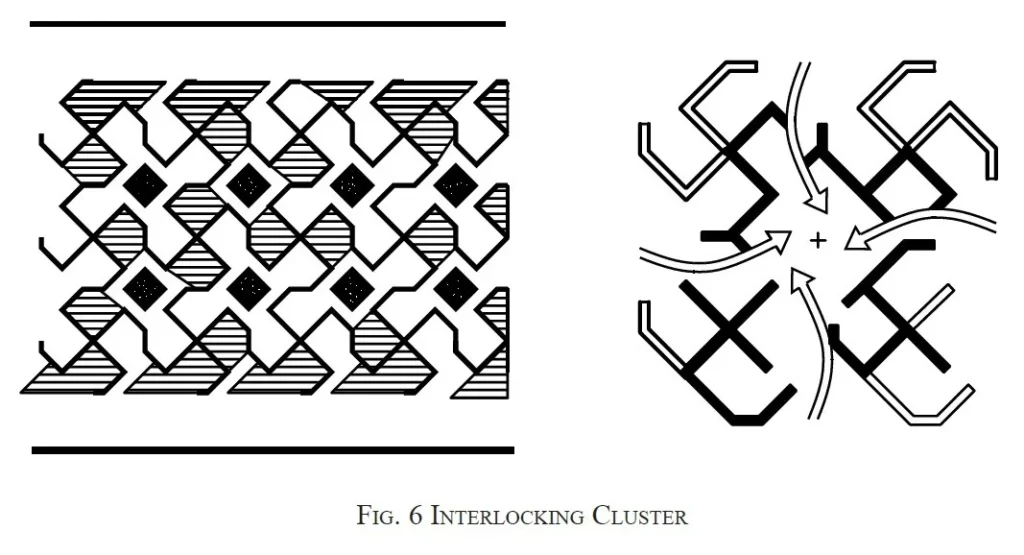
- Dwelling units in such clusters should have at least two sides open to external open space. Houses in an interlocking cluster may have access, ventilation and light from the adjacent cluster and should also cater for future growth.
vii) Internal Faces of Cluster
Building edges facing the adjacent cluster open space (as in case of interlocking cluster) of the surrounding pedestrian paths or vehicular access roads.
viii) Open Clusters
Clusters where cluster open spaces are linked to form a continuous open space.

ix) Cluster Court Town House
A dwelling in a cluster plot having 100 percent or nearly 100 percent ground coverage with vertical expansion generally limited to one floor only and meant for self use.
x) Density
- The residential density expressed in terms of the number of dwelling units per hectare.
- Incidental open spaces are mainly open spaces required to be left around and in between two buildings to provide lighting and ventilation.
Note
- Where such densities are expressed exclusive of community facilities and provision of open spaces and major roads (excluding incidental open spaces), these will be net residential densities.
- Where these densities are expressed taking into consideration the required open space provision and community facilities and major roads, these would be gross residential densities at neighbourhood level, sector level or town level, as the case may be.
- The provision of open spaces and community facilities will depend on the size of the residential community.
xi) Group Housing
Housing for more than one dwelling unit, where land is owned jointly (as in the case of cooperative societies or the public agencies, such as local authorities or housing boards, etc.) and the construction is undertaken by one Agency.
xii) Group Open Space
- Open space within a cluster. Group open space is neither public open space nor private open space. Each dwelling unit around the cluster open space have a share and right of use in it.
- The responsibility for maintenance of the same is to be collectively shared by all the dwelling units around.
xiii) Internal Faces of Cluster
Building edges facing the adjacent cluster open space (as in case of interlocking cluster) or the surrounding pedestrian paths or vehicular access roads.
2) Planning
i) Plot Size
- The minimum plot size permissible shall be 15 m2 with 100 percent ground coverage and an FAR of 2 ( Two ). 100 percent ground coverage and FAR of 2 will be applicable up to plot size of 25 m2.
- For plot sizes beyond 25 m2, provision in accordance with good practice shall be applicable given below.
- The minimum plot size with ground coverage not exceeding 75 percent, shall not be less than 40 m2 in small and medium town and not less than 30 m2 in metropolitan cities.
- Plot sizes below 30 m2 but not less than 15 m2 may be permitted in case of cluster planning, however, in such cases the ground coverage and FAR shall be 100 percent and 2, respectively (see also above).
Notes
- In exceptional cases in metropolitan cities with population more than 1 million, the size of plots may be brought down to 25 m2 in cases of low income housing colonies located in congested areas as decided by the Authority.
- In mega cities it may be further reduced to 15 m2. In such cases where plot size is below 25 m2, only cluster planning or group housing may be adopted.
- A minimum of 25 percent of the plot size shall be left open without adversely affecting light and ventilation for habitable spaces and toilet. It shall not be made mandatory to leave set back on any side.
ii) Plot/Plinth Area for Slum Resettlement on Same Site
In case of slum resettlement on the same site, minimum area may be reduced to 12.5 m2 with potential for adding another 12.5 m2 on first floor with an internal staircase.
iii) Group Housing
Group housing may be permitted within cluster housing concept. However, dwelling units with plinth areas up to 20 m2 should have scope for adding a habitable room. Group housing in a cluster should not be more than 15 m in height.
iv) Size of Cluster
- In ground and one storeyed structures not more than 20 houses should be grouped in a cluster.
- Clusters with more dwelling units may create problems relating to identity, encroachment and maintenance.
v) Size of Cluster Open Space
- Minimum dimensions of open spaces shall be not less than 6 m or 3/4th of the height of buildings along the cluster open space, whichever is higher.
- The area of such cluster court shall not be less than 36 m2.
- Group housing around a cluster open space should not be normally more than 15 m in height. Maximum cluster courtyard width and breadth shall be 13 m.
vi) Setbacks
No setbacks are needed from the edges of cluster as pedestrian/vehicular access roads surrounding the cluster.
vii) Right to Build in Sky
- Pedestrian paths and vehicular access roads to clusters separating two adjacent clusters may be bridged to provide additional dwelling units.
- While bridging the pedestrian path way minimum clearance should be one storey height, length of such bridging should be not more than two dwelling units. While bridging the vehicular access roads minimum clearance should be 6 m.
viii) Vehicular Access
A right of way of at least 6 m width should be provided up to the entrance to the cluster to facilitate emergency vehicle movement up to cluster.
ix) Pedestrian Paths
Minimum width of pedestrian paths shall be 3 m.
x) Width of Access Between Two Clusters
- Built area of dwelling unit within cluster shall have no setbacks from the path or road, space.
- Hence, the height of the building along the pathway or roads shall be not less than 60 percent of the height of the adjacent building subject to minimum of 3 m in case of pathway and 6 m in case of vehicular access.
xi) Density
Cluster planning methodologies result in higher densities with low rise structures. With per dwelling unit covered area of 15 m2 densities of 500 dwelling units per hectare (net) shall be permissible. Densities higher than this should not be allowed.
xii) Group Toilet
- Cluster housing for economically weaker section families may have group toilets at the rate of one water- closet, one bath and a washing place for three families. These shall not be community toilets, as keys to these toilets shall be only with these three families, making
- them solely responsible for the maintenance and upkeep of these toilets.
xiii) Community Open Space
- In any layout or sub-division of land measuring 0.3 hectare or more in residential zone, the community open spaces shall be reserved for recreational purposes which shall as far as possible be provided in one place or planned out for the use of the community in clusters or pockets.
- The community open spaces shall be provided catering to the needs of area of layout, population for which a layout is planned and the category of dwelling units.
- The following minimum provision shall be made for low income housing based on cluster planning:
- 15 percent of the area of the layout, or
- 0.3 hectares/1000 persons.
- No recreational space shall generally be less than 450 m2.
- The minimum average dimension of such recreational space shall be not less than 7.5 m; if the average width of such recreational space is less than 24 m, the length thereof shall not exceed 2.5 times the average width. However, depending on the configuration of the site, commonly open spaces of different shapes may be permitted by the Authority, as long as the open spaces provided serve the needs of the immediate community contiguous to the open spaces.
- In such recreational spaces, a single storeyed structure as pavilion or gymnasia up to 25 m2 in area may be permitted; such area may be excluded from FAR calculations.
- Each recreational area and the structure on it shall have an independent means of access. Independent means of access may not be insisted upon if recreational space is approachable directly from every building in the layout. Further, the building line shall be at least 3 m away from the boundary of recreational open space.
xiv) Off-Street Parking Spaces
- Off-street parking space for motorcycle/scooter/two-wheeler and bicycle not less than 1.25 m2 and 1.00 m2, respectively shall be provided at the rate of one for each tenement. Parking space may be provided at community level.
- In such a case, in addition to the parking space to be provided as above for each tenement, space provisions shall be made for other types of vehicles, such as ambulance and disaster management vehicle, and also for additional spaces required for other vehicles, which shall be as decided by the, keeping in view the nature of traffic generated in the city.
xv) Typical Plans for Cluster Planning Development
- Typical plans of cluster planning development showing built space variation in linear cluster development option.

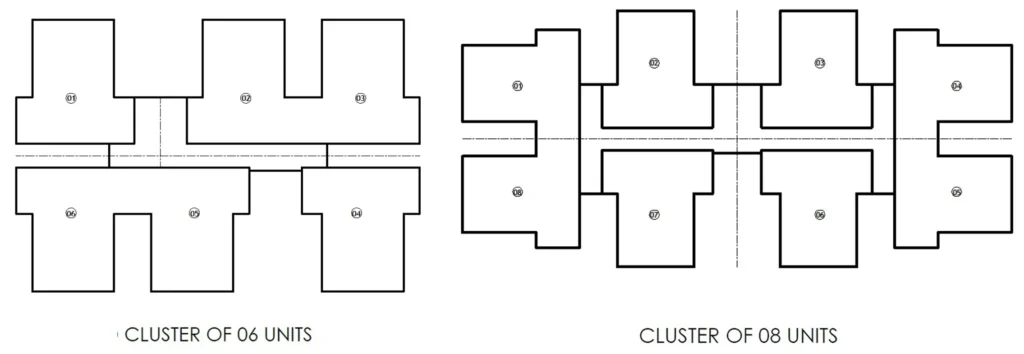
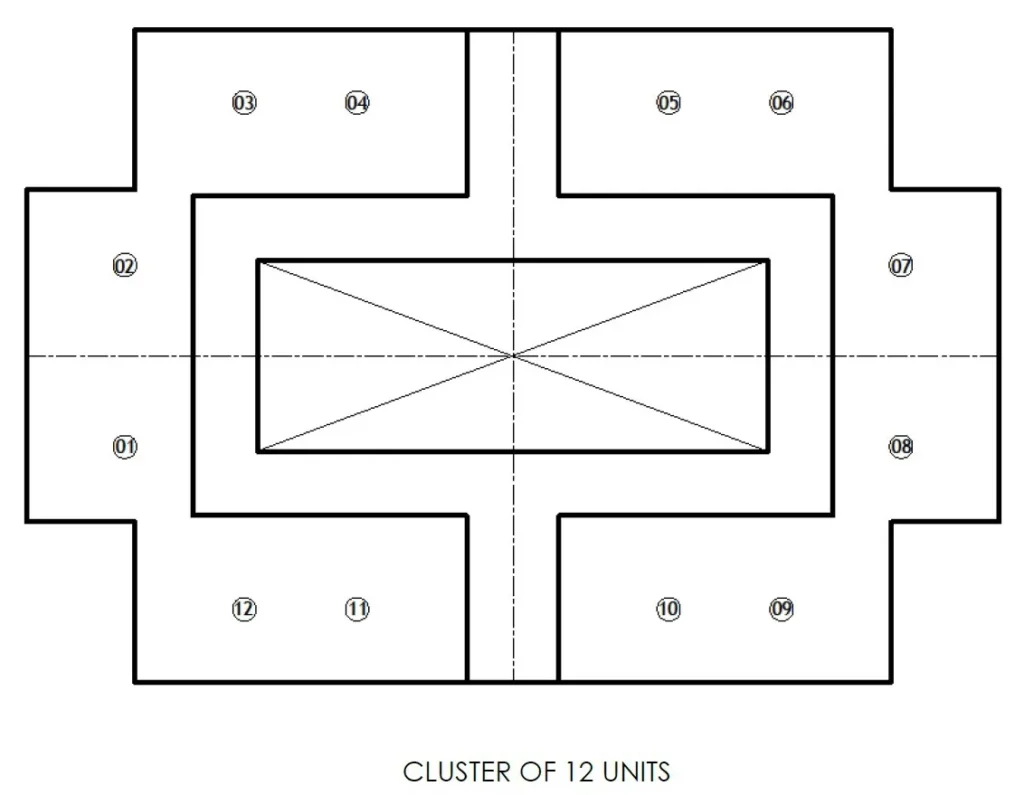
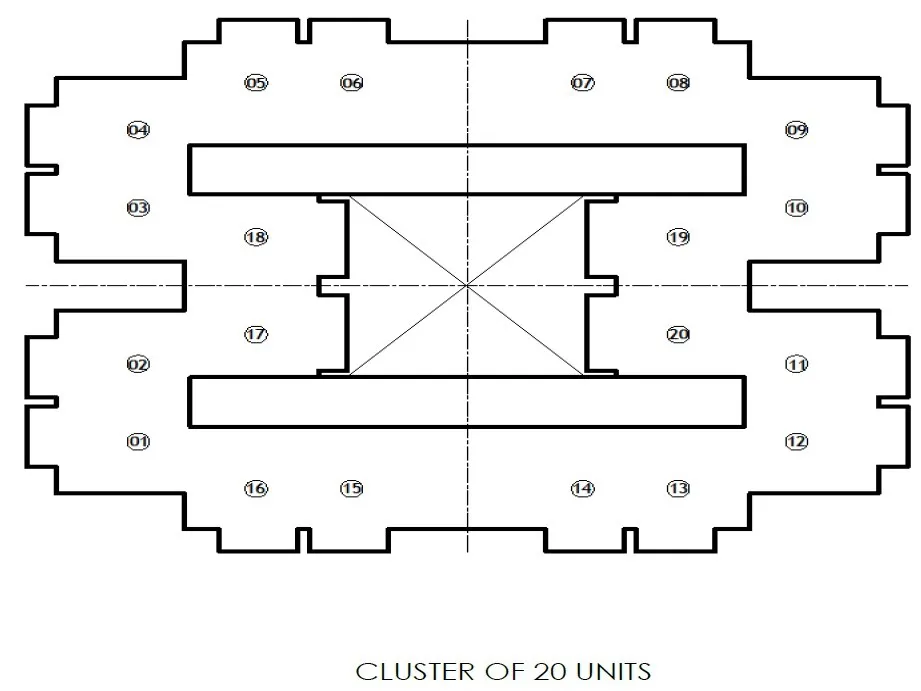
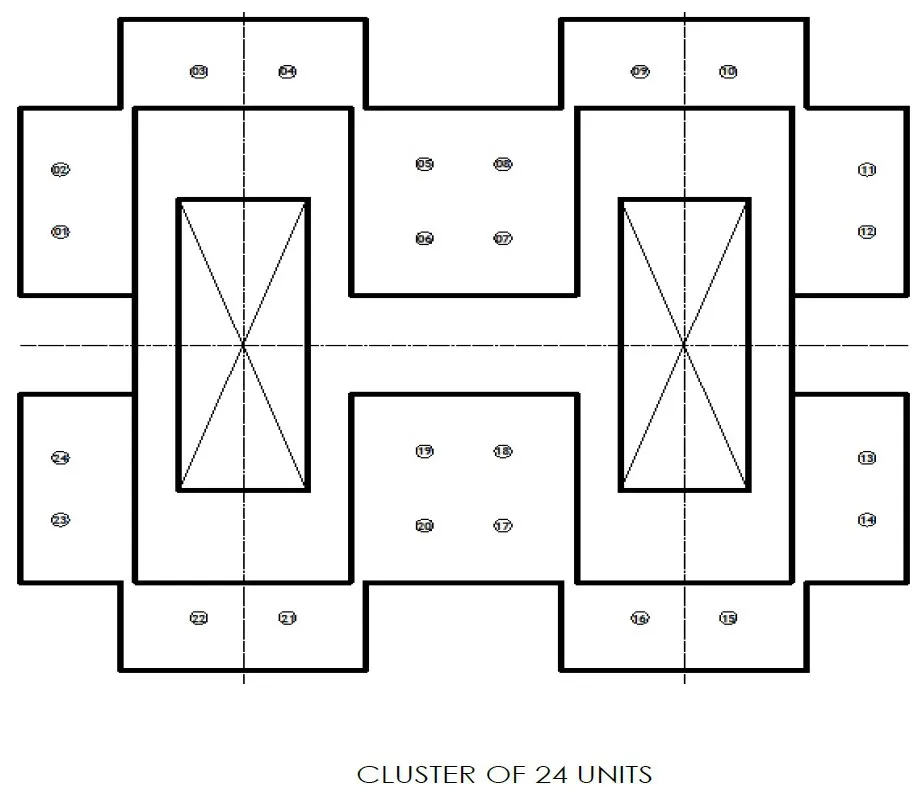
3) Other requirements
- Requirements of fire safety, structural design, building services and plumbing services shall be as specified in the NBC Code.